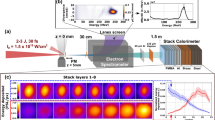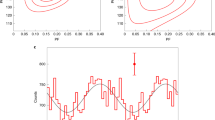Abstract
WE report the observation of sudden changes in the intensity of Sco X-1 by a factor of about three in the energy interval 29.9–52.3 keV on December 22, 1968, between 0427 h and 0553 h UT. The observation was made with an X-ray telescope in a balloon flight from Hyderabad (latitude 17.6° N, longitude 78.5° E), India. The telescope consisted of an NaI(Tl) crystal with an area of 97.3 cm2 and thickness 4 mm surrounded by both active and passive collimators. The passive collimator was a cylindrical graded shield of lead, tin and copper and the active collimator was a plastic scintillator surrounding the shield. The field of view of the telescope at f.w.h.m. was 18.6°. The axis of the telescope was inclined at an angle of 32° to the zenith. The telescope was mounted on an oriented platform programmed to look in four specified directions successively, spending about 4 min in each direction during a cycle of period about 16 min. The four specified directions were N(ϕ = 0), SW(ϕ=110°, with the convention ϕ = 90° being due west), S(ϕ = 180°, due south) and NE(ϕ = 310°). In this flight the orienter performed satisfactorily and the telescope picked up Sco X-1 in the south direction, Cyg X-1 in the direction NE(ϕ = 310°) and a new source in the direction SW(ϕ = 110°). In the north direction (ϕ = 0) there was no source during the period of observation and therefore the information on background X-rays was obtained from this direction. The observations of the short term changes of intensity of Sco X-1 are discussed here—the results from the other data will be published separately. A pair of crossed flux gate magnetometers provided information every 8.2 s on the azimuth of the telescope. The pulse heights from the X-ray detector were sorted into nine contiguous channels extending from 10 to 120 keV. Counting rates of several channels were combined for analysis to improve the statistics. A 241Am source came into the field of view of the telescope once in 15 min for about 30 s to provide in-flight calibration of the detector and this indicated that there was stable operation and no drift in the channel positions during the flight. The balloon was launched at 0200 h UT and reached the ceiling altitude at 0435 h. Between 0435 and 0530 h, the ceiling altitude was 7.6 ± 0.3 g cm−2. Just before the balloon reached the ceiling Sco X-1 was in the field of view of the telescope for 3 min 41 s when the balloon was ascending from 9.2 to 8.3 g cm−2. After the balloon reached ceiling, Sco X-1 was in the field of view on five occasions between 0443 and 0553 h. During the last observation, 0551–0553 h, however, the floating altitude of the balloon was a little lower, 8.5 g cm−2. The meridian transit of Sco X-1 was at 0454 h and the flight was terminated at 0615 h.
This is a preview of subscription content, access via your institution
Access options
Subscribe to this journal
Receive 51 print issues and online access
$199.00 per year
only $3.90 per issue
Buy this article
- Purchase on Springer Link
- Instant access to full article PDF
Prices may be subject to local taxes which are calculated during checkout
Similar content being viewed by others
References
Lewin, W. H. G., Clark, G. W., and Smith, W. B., Astrophys. J. Lett., 152, L55 (1968).
Chodil, G., Jopson, R. C., Mark, H., Seward, F. D., and Swift, C. D., Phys. Rev. Lett., 15, 605 (1965).
Peterson, L. E., and Jacobson, A. S., Astrophys. J. Lett., 145, L62 (1966).
Lewin, W. H. G., Clark, G. W., and Smith, W. B., Astrophys. J. Lett., 150, L153 (1967).
Chodil, G., Mark, H., Rodrigues, R., Seward, F. D., Swift, C. D., Turiel, I., Hiltner, W. A., Wallerstein, G., and Mannery, E. J., Astrophys. J. Lett., 154, L645 (1968).
Bradt, H., Naranan, S., Rappaport, S., and Spada, G., Astrophys. J. Lett., 152, L1005 (1968).
Overbeck, J. W., and Tanabaum, H. D., Astrophys. J. Lett., 153, L899 (1968).
Author information
Authors and Affiliations
Rights and permissions
About this article
Cite this article
AGRAWAL, P., BISWAS, S., GOKHALE, G. et al. Sudden Changes in the Intensity of High Energy X-Rays from Sco X-1. Nature 224, 51–53 (1969). https://doi.org/10.1038/224051a0
Received:
Revised:
Issue Date:
DOI: https://doi.org/10.1038/224051a0
This article is cited by
-
Sco X-1
Space Science Reviews (1977)
-
Balloon observations of Sco X-1 in the energy interval 17?106 keV
Astrophysics and Space Science (1973)
-
Observation of a Hard X-ray Flare in Cyg X-1
Nature Physical Science (1972)
-
Time variations of hard X-rays from Sco X-1
Astrophysics and Space Science (1972)
-
The flattening of the X-ray spectrum of sco X-1 at energies beyond 40 keV
Astrophysics and Space Science (1971)
Comments
By submitting a comment you agree to abide by our Terms and Community Guidelines. If you find something abusive or that does not comply with our terms or guidelines please flag it as inappropriate.



